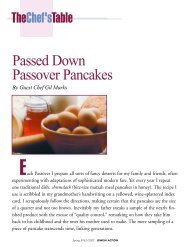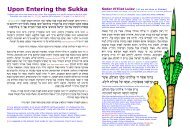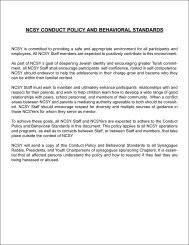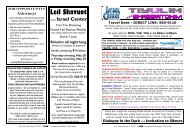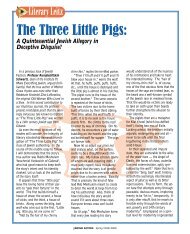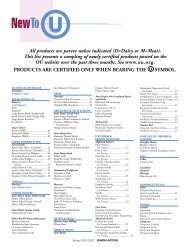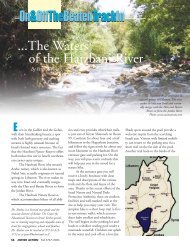EATING THEIR WHEATIES: - OU Kosher
EATING THEIR WHEATIES: - OU Kosher
EATING THEIR WHEATIES: - OU Kosher
Create successful ePaper yourself
Turn your PDF publications into a flip-book with our unique Google optimized e-Paper software.
❝<br />
On my trip, the beauty of the environment was<br />
matched only by the generosity and hospitality of the<br />
plant managers, quality control personnel, and by all<br />
citizens whom I was greeted by there. ❞<br />
FROM ALASKA – THE CALL<br />
OF THE WILD (SALMON)<br />
By Rabbi Chaim Goldberg<br />
ALASKA IS THE PLACE where wild Pacific salmon<br />
return to spawn and die after their long journey at<br />
sea. It is the wild salmon fishing capital of the<br />
world, and it is home to several <strong>OU</strong> kosher certified<br />
salmon canneries. This summer I traveled from the<br />
crowded, humid streets of my native Brooklyn, NY to<br />
visit the pristine expanse of Alaska to review the kosher<br />
programs at many of our Alaskan canneries with our<br />
Rabbinic Field Representative from Vancouver, British<br />
Columbia, Rabbi Levy Teitlebaum.<br />
Although I had noted, even as a child, the large<br />
mass that Alaska takes up on a map of the United States,<br />
I never realized how secluded communities are from<br />
one another. Even the capital, Juneau, can only be<br />
reached by ferry or plane from most of the state! It’s a<br />
lot of work just to coordinate travel between nearby<br />
cities. During the five days Rabbi Teitlebaum and I were<br />
there, we saw 11 canneries in six different cities and the<br />
overwhelming majority of the time we were in transit.<br />
Most days we were awake before 6:00 a.m. and did not<br />
return to our hotel until after 9:00 p.m. We took two<br />
commercial carriers through nine cities, one “bush<br />
plane” (which could not find the lake the pilot was<br />
supposed to land in and, instead, put the plane down in<br />
a local harbor and docked like a boat… real fun!), one<br />
rental car, two ferries, three taxies and countless “company<br />
limousines” — often commissioned following<br />
their escape from the local recycling facility. I’m amazed<br />
at the tenacity, patience, and hard work of Rabbi Teitlebaum,<br />
who does all this regularly — and has been<br />
stranded sometimes for days due to weather conditions!<br />
Salmon canneries are located near the freshwater<br />
streams to which wild salmon return to spawn before<br />
dying. Fishing boats, many armed with satellite tracking<br />
technology, can locate and catch an entire school of<br />
salmon in one run. Much of the salmon is sold directly<br />
Rabbi Levy Teitelbaum getting ready to board with his bush pilot<br />
to visit the next Alaskan plant only accessible with small plane<br />
to canneries or to tenders, which are larger sea vessels<br />
that act as a kind of broker to individual canneries.<br />
At the canneries, salmon are sorted by quality and<br />
species before being loaded by hand into equipment<br />
that will remove the head, tail, innards, and eggs. The<br />
fish are hand-trimmed, cut to portion size, canned and<br />
cooked in a steam retort oven.<br />
Where does the <strong>OU</strong> fit in? As all <strong>OU</strong> company contacts<br />
know, there are three parts of the certification program:<br />
ingredients (Schedule A), products (Schedule B),<br />
and process. Salmon and salt, the ingredients in canned<br />
salmon, are intrinsically kosher. The products are essentially<br />
“brite stack” (unlabelled cans, identifiably only by<br />
can and production code). My focus, therefore, was on<br />
the production process. We know that some canneries<br />
produce fish other than salmon during the year. One<br />
concern focused on factories that process non-kosher<br />
fish such as crab and skate. We sought to confirm that<br />
they process non-kosher fish only on dedicated equipment<br />
in a process that cannot be duplicated on the<br />
kosher equipment. We looked into the “patching”<br />
process (the addition of a small piece of salmon to an<br />
otherwise underweight can) to be sure that no foreign<br />
fish were being added. We also confirmed that workers<br />
do not take knives out of the production facility (for<br />
personal, potentially non-kosher use), and that there is<br />
no use of “incidental additives,” i.e. release agents, flow-<br />
8 BEHIND THE UNION SYMBOL FALL2003



